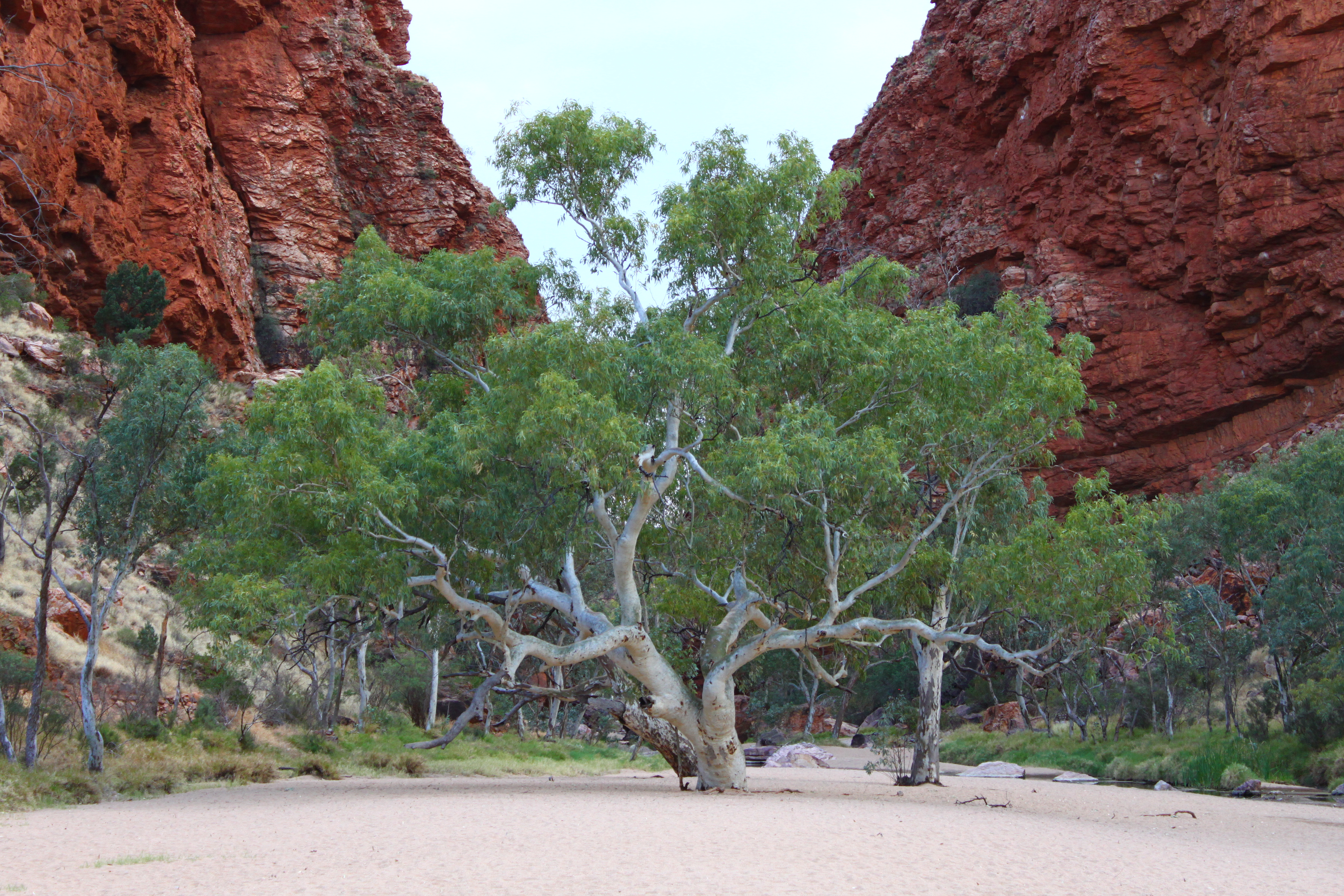River red gum (Eucalyptus camaldulensis)

Country: Australia
Common name: River red gum, a canoe tree
Scientific name: Eucalyptus camaldulensis
Family: Myrtaceae
Synonymy:The genus eucalyptus is derived from the Greek eu meaning ‘well’ and calpytos meaning ‘covered’ and refers to the eucalypt seed caps (operculums). The species camaldulensis refers to Camalduli, a region in Tuscany, Italy where German botanist Frederick Dehnhardt named
the species in 1832. The common name refers to the distribution of the species in riverine
ecosystems and the colour of the heartwood.
Cultural, Social and Spiritual Value
A medium to tall impressive tree that ranges from 12 to 45 metres, with a thick trunk, heavy twisting branches and spreading open crown, Eucalyptus camaldulensis is culturally and historically important. Indigenous Australians used the bark of mature trees to form canoes and shields carved from the trunks of individual trees. Relic trees remain as scar trees, or 'canoe trees', particularly along the banks of the Murray River and its tributaries. Australian artists have used E. camaldulensis as a source of inspiration, most notably South Australian landscape painter Sir Hans Heysen.
General Background
A common and widely distributed tree throughout the rural landscape, riverine and roadside corridors of much of mainland Australia, and especially of eastern Australia, Eucalyptus camaldulensis (River red gum) is considered an iconic tree for its omnipresence and majesty of form with a thick trunk, heavy twisting branches and spreading open crown. It is well recognised for its wide range of values including for hard-wearing resilient timber used in heavy construction such as piers and old warehouses, flooring, railway sleepers, framing, fencing, firewood and charcoal production. Bark from the species was historically used by Indigenous Australians to make canoes and shields. E. camaldulensis is of major importance to the honey bee industry, and is the most widely planted species in arid and semi-arid regions globally, primarily in timber plantations.
Geographical Distribution
Eucalyptus camaldulensis is most commonly found in perennial and intermittent riverine ecosystems and floodplains of the semi-arid and arid inland regions as well as alongside watercourses in the temperate south-east of the Australian continent. The species is particularly common alongside the many rivers and tributaries of the Murray-Darling Basin. The species is only absent from southern Western Australia, the coastal fringe of the east of the mainland, and Tasmania. Eucalyptus camaldulensis is a dominant species within the Australian landscape; however, no specific data are available relating to abundance.
Current Population Trends
E. camaldulensis shows morphological variability and five subspecies are known.
- E. c. acuminata is mainly found in Queensland in the north east of Australia
- E. c. camaldulensis is found in the south east of Australia and across the Murray- Darling Basin
- E. c. obtusa occurs in the tropical north of the continent of northern Queensland, the Northern Territory and Kimberley region of Western Australia
- E. c. simulata is found in the tropical north of Queensland; and
- E. c. subcinerea is widely distributed across the semi-arid and arid interior of the
continent.
Habitat
Eucalyptus camaldulensis typically is found in riverine ecosystems, but is also found in open forest or woodland forest structures on flood plains. E. camaldulensis grows in a variety of climatic conditions from warm to hot and sub-humid, to semi-arid and arid climates. It is a frost tolerant species and grows in areas with average low temperatures of 3-15°C and in areas with average high temperatures of 27-40°C. It predominantly grows in areas with rainfall between 250-600 millimetres (mm), but can be found in areas with rainfall as low as 150 mm and as high as 1250 mm. Trees in low rainfall and arid areas rely on seasonal flooding and/or elevated water tables. Trees within floodplains can survive for long periods (up to two to four years) of inundation, however, permanent inundation will lead to tree death. E. camaldulensis has a moderate salt tolerance.
E. camaldulensis grows in a range of soils including heavy to light clay, loam, sandy loam and sand. It is most common in heavy grey clay soils on stream banks and flood plains and red and brown clay soils of the Murray River region.
Major Current and Potential Threats
The main threats faced by Eucalyptus camaldulensis are grazing and fire.
E. camaldulensis can face pressures during drought or prolonged dry periods when feed for native animals (kangaroos), introduced pest species (rabbits) and grazing livestock is scarce. E. camaldulensis is a fire sensitive species. Seedlings are particularly susceptible to fire and mature trees are also vulnerable depending on fire intensity as some E. camaldulensis subspecies often lack lignotubers (root stock) and the associated post-fire lignotuber regrowth mechanism.
Alteration of stream flow and flooding regimes can lead to decline in health, or death of individuals or stands of E. camaldulensis.
Conservation and Protection Status
Eucalyptus camaldulensis is commonly found across Australia and is not regarded as at risk.
Bibliographic References and Web Sites
- Boland, D, Brooker, M, Chippendale, G, Hall, N, Hyland, B, Johnston, R, Kleinig, D, McDonald, M & Turner, J 2006, Forest trees of Australia, 5th edn, CSIRO Publishing, Melbourne.
- Costermans, L. 2009. Native trees and shrubs of south-eastern Australia. Reed New Holland Publishing, Sydney.
- www.anbg.gov.au/cpbr/WfHC/Eucalyptus-camaldulensis/
- www.florabank.org.au/lucid/key/species%20navigator/media/html/index.htm#E
